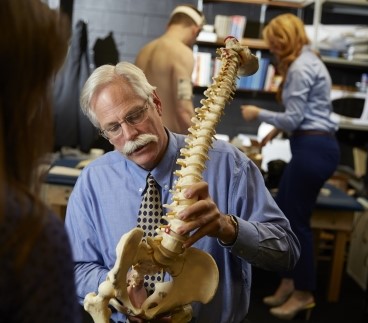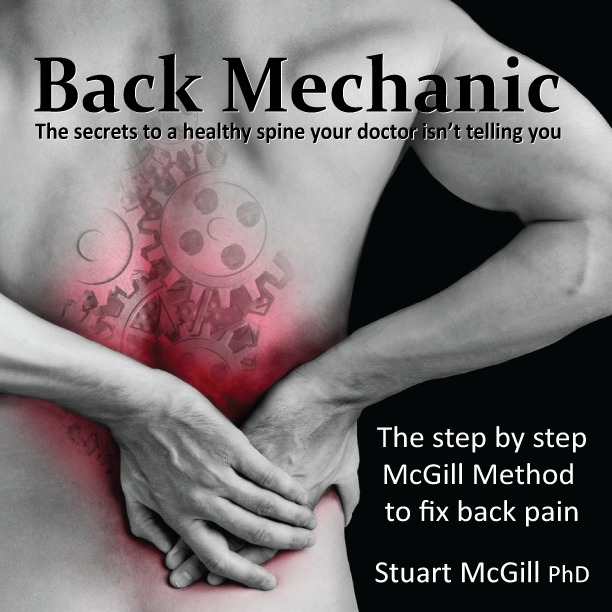Stuart McGill has been on my radar for some time, and his book, Back Mechanic was the item on my to-read list that I was most hoping to tackle. But I shuffled my feet for months because I had such trouble finding a copy.
As a rule, I don’t like to pay for a book unless I’m sure it’ll be worth the sticker price. But I could not for the life of me find a free or cheap copy anywhere. Since my personal rule of thumb is, “Beware doctors who do their own marketing,” I was prepared to have my hopes dashed. Since the only way I was going to assuage my curiosity would be to read it, I eventually gave in and clicked “Buy.”
Now I’ve read it, I’ve absorbed it, and I would say that the $35 I spent on this book is the best $35 I’ve spent on spine care.
Any budding complaints died on my lips somewhere around Chapter 2. Unlike most other books I’ve read that cater to patients, this one was straightforward and packed with information. Refreshingly, it did not seem to assume that I am a couch potato who is incapable of following a doctor’s advice.
In the Acknowledgements section, McGill admits, “It is difficult to remove my medical jargon and replace it with common everyday language.” He credits his son John with doing the translation, and both influences are apparent. The book reads like an abbreviated version of a textbook, with everything removed except the parts that are useful to patients. It is also very readable, even for someone with no medical background.
Several times, I was shocked to see McGill neatly summarize lessons I had learned the hard way. He suggested that the short-term benefits of back surgery are mostly due to the act of recovering from back surgery. That was my experience, 100%. And there was an entire chapter dedicated to the importance of walking! At long last, I had a reason for why brisk walking feels so much better than a slow meander through the mall.

So how do you fix back pain, according to McGill? You focus on postural changes and stiffening the core. In McGill’s book, “core” does not mean “abs” in the gym-centric six-pack sense. “Core,” means the muscles that support the spine and torso. Follow McGill’s program, and you will have a strong, resilient back that won’t turn any heads at the beach (except, hopefully, your own).
As for posture, McGill describes the spine’s shape and how it bears loads. When you flex the spine in certain ways, you are placing undue stress on the vertebrae and discs. Even a casual movement like pulling on your socks can cause pain if not done with good form. If you regularly move in ways that are bad for your spine – especially if you’re bearing loads – you risk injury. If you are already injured, you may not be able to heal properly, and you are likely to re-injure yourself in the future.
He goes into detail about the best ways to bend, lift, sit, stand, and generally move. He includes illustrations showing how to do laundry, how to brush your teeth, and how to sit on the toilet. My particular favorite showed the right and wrong way to sneeze. In short, he’s thought of everything. (Why, yes. There are illustrations showing suggested sexual positions!)
He emphasizes the importance of stiffening the torso to spare the spine when moving or lifting. His core program (pun unavoidable) consists of three exercises: the bird dog, the side plank, and the curl up. The exact form and timing for each exercise is important, and he gives detailed instructions.
Above all, McGill shows himself to be an experienced clinician. He has clearly seen enough patients to predict how they will fail, and tries to stop them before they do. His advice to type A personalities was especially helpful for me:
Typically, when I give a type A an exercise with eight repetitions as part of their routine, they will go away and do sixteen and then return wondering why their back didn’t get better. They are the ones who state they have to get to the gym for their aerobics everyday, fearing that a day off will cost them their fitness. If this sounds like you, you must give yourself permission to take it easy. Recovery will not be possible if you continue to push yourself to your limits.
Later, he specifically cautions against adding unnecessary time or reps to his core program. Without this specific admonishment, I absolutely would have done more.
If you are more of a type B, McGill offers this advice instead:
In contrast, a type B individual with a more laid back personality will hear my prescription for eight reps and then think of an excuse as to why they only need to do four reps that day. If this scenario is more your style, it’s time for you to step it up. If you’re serious about ridding yourself of pain, you have to be serious about taking the steps needed to experience a proper recovery. Teach yourself to be more diligent with your daily regimen and you are more likely to succeed.
The only thing I’m not yet game to try is McGill’s nerve flossing technique, which is specifically for sciatica. Sitting down seems absolutely unavoidable during nerve flossing, and I haven’t worked up the courage to try. I’ll stick with the core program for a few weeks. If they help, and I build up enough trust, I may give this flossing thing a go.
Although I scrutinized every page in this book, I couldn’t absorb all the information in one go. Every time I’ve looked up a section to refresh my memory, I rediscover some point I’d already forgotten about. I suspect this is a book that I’ll end up revisiting time and again until I see the words printed across the back of my eyelids.
Does McGill’s program work for me? The jury’s still out. As of this writing, I’ve been following the plan in his book for all of six days. While my legs have been less bothersome than usual lately, I still don’t know whether to call that coincidence or a result.
Even if this doesn’t end up being a magical cure, the advice in Back Mechanic is still solid and practical enough for everyday use. This is the first book I’ve read about back pain that I would recommend to everyone with a back, regardless of their pain level.
If you take nothing else away from this book, remember: Sneeze up.

9 thoughts on “Book Review: Back Mechanic by Dr. Stuart McGill”